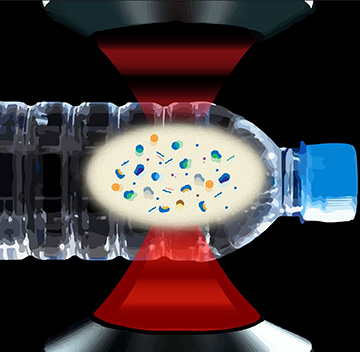
An imaging platform based on stimulated Raman scattering can detect and identify plastic particulates in real-life samples such as bottled water. [Image: Naixin Qian, Columbia University]
Researchers at Columbia University, NY, USA, have shown that an imaging approach previously used to study biological processes can also count and identify nanoscale plastic fragments in bottled water (Proc. Natl. Acad. Sci. USA, doi: 10.1073/pnas.2300582121). In the group’s tests, the method’s enhanced sensitivity to smaller particulates revealed that a single liter of bottled water can contain several hundred thousand plastic pieces. That’s two to three orders of magnitude higher than earlier estimates.
Unseen concerns
Microplastics and nanoplastics are known to be present in natural ecosystems, food and drink, and water supplies—with growing concern that nanosized particles are small enough to enter the bloodstream as well as individual cells. Scientists urgently want to investigate the possible effects of nanoplastics on biological systems and processes. But most analytical techniques that can detect them are unable to discern their chemical composition.
In their newly reported work, the Columbia University researchers exploited an imaging platform based on stimulated Raman scattering, which they showed offers rapid detection of individual plastic particles down to 100 nm in size. The team used the platform to count tiny plastic fragments in small samples of bottled water from three different brands. From their measurements, the researchers estimated that each liter contained, on average, 240,000 plastic particles, some 90% of them smaller than 1 µm.
From numbers to composition
While the spectral information on its own is unable to reveal the chemical composition of individual fragments, the researchers devised a data-driven algorithm that matches the experimental data with the spectral signatures of seven common polymers. One of the materials they identified was polyethylene terephthalate (PET), the plastic widely used for soft-drink bottles. Another was a type of nylon used in the filters that purify water before bottling.
The researchers estimated that each liter of bottled water contained, on average, 240,000 plastic particles, some 90% of them smaller than 1 μm
The technique also enabled the researchers to measure the morphology of individual particles—measurements that showed each type of plastic has a different shape and size distribution. Such information, they say, could help in tracing and eventually eliminating specific sources of plastic contamination. It could also afford a better understanding of the interactions between different plastics and biological systems.
Eyeing unidentified particles
However, the researchers also note that the seven polymers they analyzed account for only 10% of the fragments found in the samples. A number of spectral features indicated the chemical presence of PET in some of the unidentified particles, suggesting that the plastic had formed an aggregate with another component—possibly natural organic matter. More rigorous identification will require an expanded library of spectral signatures or improved analytical techniques.
The team now wants to use its platform to analyze micro- and nanoplastics in other types of sample. A project is underway to study particulate matter in the wastewater from laundries, which would enable the design of better filters. The researchers are also collaborating with environmental health experts to measure and investigate the effects of nanoplastics in various human tissues.
